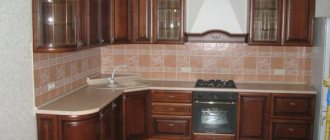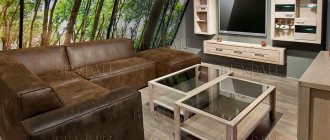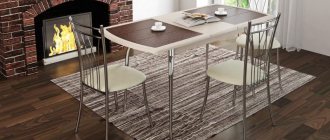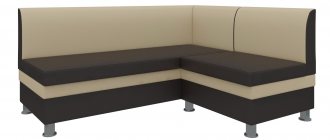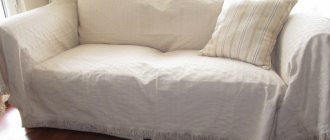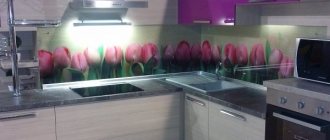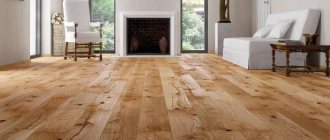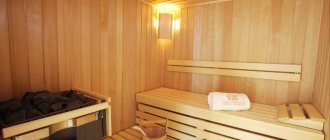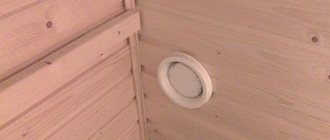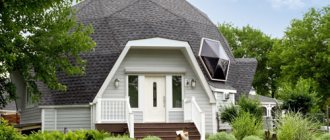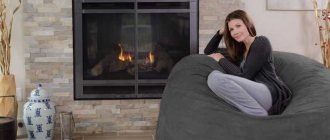Kitchen material
The service life of kitchen furniture, its appearance and functionality directly depend on the material from which it is made. You can buy the cheapest possible product, but it will not withstand operation with constant fluctuations in temperature and humidity. Therefore, you should select the optimal solution that will be affordable, but at the same time have suitable technical characteristics.
Kitchen building
Modern kitchens are made from four main materials. The most luxurious is solid wood. These are expensive options made from natural wood without adhesives. For use in conditions of high humidity, wood is treated with hydrophobic compounds. Most often, solid wood kitchens are made exclusively to order; the style is selected based on the overall design of the room. Their high cost is compensated by their very long service life.
In addition to natural wood, the following materials are used to make kitchen furniture:
Multiplex is an alternative to natural wood. Multiplex panels are a laminated material made from wood lamellas. Thanks to the perpendicular arrangement of fibers in the layers, kitchen elements do not deform under the influence of high humidity and temperature. For gluing, environmentally friendly resins are used, which have a minimal level of formaldehyde emissions. They are safe for human health.
MFD is a relatively cheap glued material consisting of a finely dispersed fraction of wood glued together using polymer resins under high pressure. Thanks to the use of resins, MDF has increased hydrophobic properties and a long service life. The appearance depends on the type of laminating film used. It can imitate the color and texture of natural wood.
Chipboard is an older material that is now sometimes used in kitchens. Chipboards are made from wood chips and do not withstand moisture well. Especially in places where there are cuts at the ends, where there is no protective film. Kitchens made from chipboard are the cheapest, but have the shortest service life.
Facade
The facade refers to the front part of the kitchen, on which its appearance and functionality depend. For the manufacture of facades, the same material can be used as for the rest of the structure, that is, MDF or solid wood. However, to reduce the cost of structures and improve the appearance, other options are used:
Frame facade - made of MDF in the form of a frame, into which glass, plastic, and rattan panels are then inserted. The frame design gives wide scope for the imagination of designers, and kitchens based on them are inexpensive.
Veneered facade - in this case, the base of the front panel is also made of MDF, after which the outer surface is covered with natural wood veneer. This reduces the cost of the design, but gives it a beautiful appearance. Veneered facades last a long time and can be restored if necessary.
Postforming is a special technology for manufacturing facades. A polymer material or continuous pressing laminate is used, which is glued to an MDF base on all sides. This allows you to implement complex design solutions and reliably protect the glued panel from adverse external influences.
Tabletop
The working part of the kitchen unit experiences increased mechanical stress during operation. Therefore, when choosing, you should be guided not only by the design, but also by the strength of the material. The following options are used:
Artificial stone - countertops of this type are made from stone chips and polymer resins. Unlike products made from natural stone, such countertops can be given any, even the most complex, shape. They do not deteriorate from contact with aggressive substances, are not stained by food products, can withstand impact, but are afraid of high temperatures.
Moisture-resistant chipboard is a laminated material based on wood chips and polymer resins. Hydrophobic substances are added to the adhesive composition, which repel moisture and protect the tabletop during operation. A decorative and protective coating of increased strength is glued to the surface of the chipboard, which can withstand the effects of sharp objects and aggressive substances.
Natural stone - marble or granite is used. It has an unlimited service life and beautiful appearance, but does not withstand impact. Instead of expensive natural stone, artificial stone is often used. It is made from stone chips and polymer resins. Devoid of the disadvantages of natural materials, the tabletop can have a complex geometric shape.
Accessories
Kitchen furniture will not be as comfortable to use without high-quality fittings. This includes various types of hinges, door closers, gas lifts, retractable mechanisms and roof rails.
Modern fittings are, first of all, a universal assistant that allows you to conveniently, efficiently and, most importantly, silently use sashes and doors and additional filling systems.
Choosing high-quality fittings is the key to long-term use of the kitchen!
Solid wood
Wood is the most famous, and previously uncontested, natural material. Wood can be called a traditional material for making kitchen facades: the first kitchens were made only of wood. To increase the service life of wood facades, the surface is treated with special septic tanks and varnishes.
Solid wood facades can be solid or paneled. Solid facades are made only from wood, have greater weight and price when compared with paneling. Internally paneled facades are made of MDF or chipboard, and the façade frame is made of solid wood.
| Advantages: | Flaws: |
|
|
- 1 of 4
On the picture:
What color of kitchen set should I choose?
When choosing a color scheme, it is necessary to take into account the design of the entire room. However, interior design experts also advise taking the following tips into account:
Dark glossy - this option looks beautiful in any room, but requires increased care. Dried drops of water, dust, and fingerprints will be clearly visible on the facades.
Glossy white is a universal color and surface texture for rooms of any size. Unlike dark gloss, drops, dirt, and fingerprints are practically invisible on light gloss. It is very easy to care for such a kitchen.
Dark shades visually reduce the area of the room, so they are not recommended for use in small rooms in city apartments.
Yellow tones “brighten” the room in case of lack of natural light.
Blue and beige pastel colors are appropriate in rooms with large windows through which a lot of light from the street enters.
When choosing a color, it is not recommended to use “poisonous” shades, which will irritate the eyes and quickly go out of fashion. It is better to use colors of natural origin. When choosing a kitchen painted in two colors, you must use light for the upper part of the set and dark for the lower part. Otherwise, the cabinets will “press” on you, which will make staying in the room uncomfortable.
Kitchen styles
The design of furniture for the kitchen, like the color, directly depends on the chosen design style. Most often, designers use the following options:
Classic - furniture in this style is most often made from natural materials or their imitation, painted in natural tones. Wood, stone, bronze, brass are used.
Minimalism - the main features of this option are simplicity and high functionality. No complex design elements or fancy accessories are used.
Modern is a style characterized by simplicity of lines and severity of additional elements. To paint Art Nouveau furniture, two contrasting colors are usually used.
Provence is a Mediterranean style, which is characterized by pastel blue and beige tones, artificially aged surfaces, and the use of wood as the main material.
High-tech - kitchens with simple shapes and without a large number of additional accessories. Steel, plastic, glass are used. The color is neutral, without bright colors or patterns.
Country is an American rustic style characterized by the use of wood. Ceramic dishes and textile elements are used as accessories and additional elements.
Loft is a separate direction in design, which is characterized by the use of rough surfaces, artificially aged metal, and ceramic bricks.
Kitchen furniture shapes
Another important factor when choosing is the shape and arrangement of furniture elements. When choosing, you need to take into account the shape and size of the room. The following options are common:
In the shape of the letter L - a classic option for city apartments and small spaces;
In the shape of the letter P , the kitchen is placed along three walls of the kitchen, providing maximum space for placing household appliances and products. However, in this case there is no space left for the dining table;
Direct - furniture is installed along one wall of the kitchen. An excellent option for very small spaces.
Double-row – a kitchen that is placed along opposite walls of the room. It has the same advantages as the U-shaped one. But this leaves room for the front door and window, located on two opposite walls.
Island - a kitchen with a separate module - an island - which can be placed anywhere in the room. Plus - the convenience of cooking. The downside is the need for a large area.
MDF covered with natural veneer
Natural veneer facades are visually as close as possible to expensive facades made of valuable wood, but they cost less, so they are highly popular among buyers in the expensive segment. Veneer is a cut of valuable wood, which is used to cover the MDF board, which is the basis of the facade. Special technologies and chemical compositions make it possible to give MDF veneer facades high strength, as well as increased moisture resistance. Veneer facades are often used in classic interiors.
| Advantages: | Flaws: |
|
|
- 1 of 3
